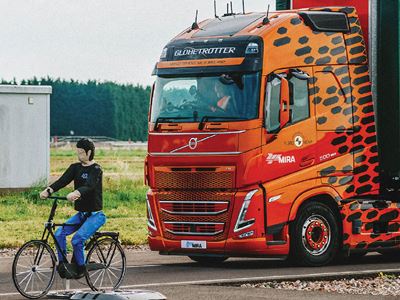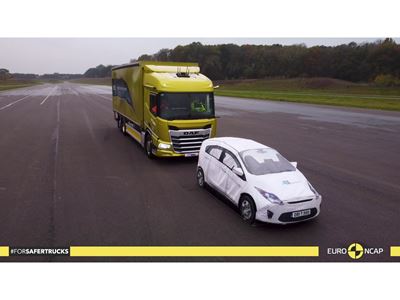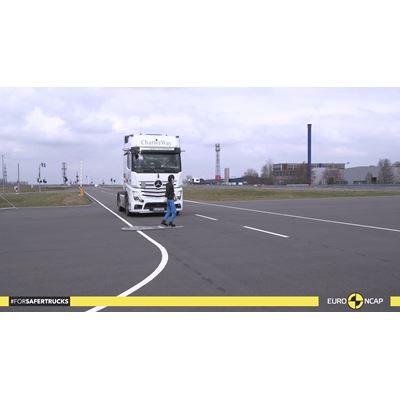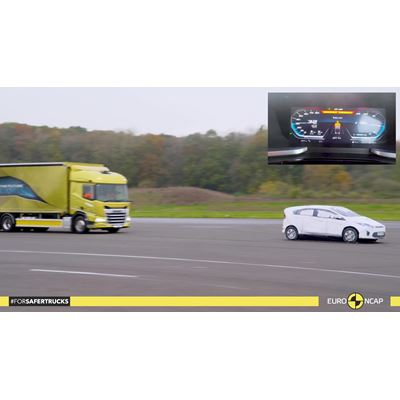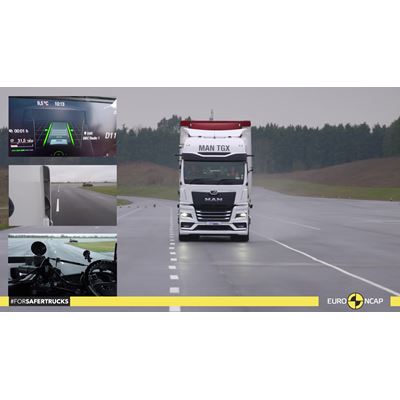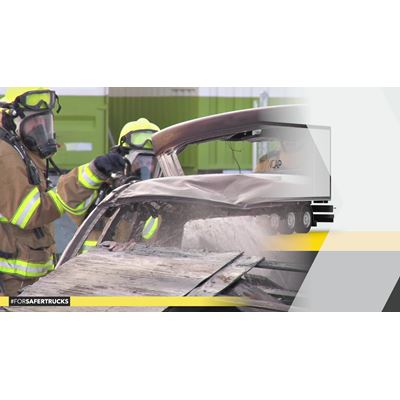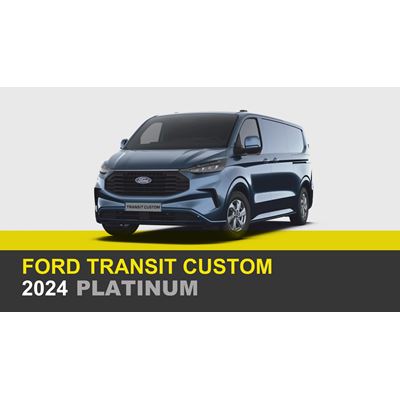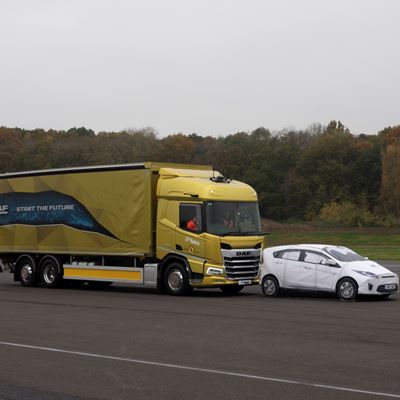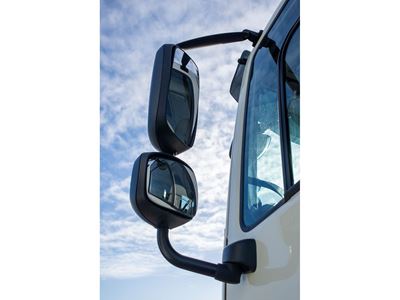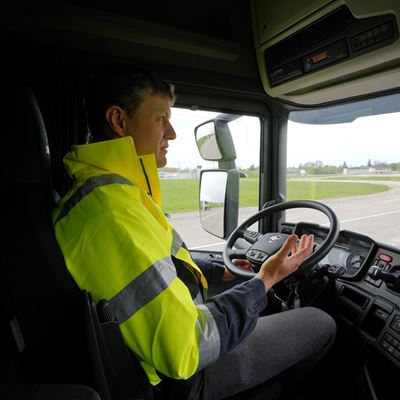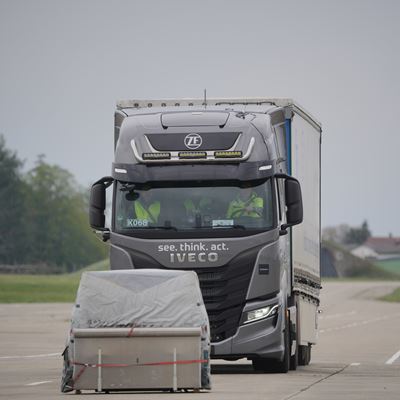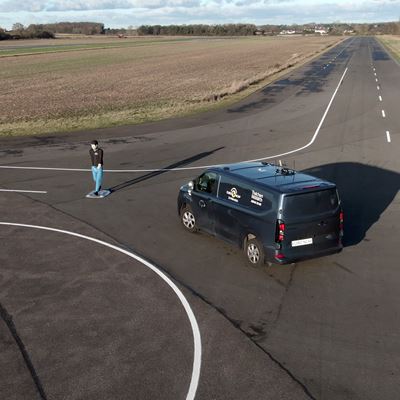Euro NCAP reveals details of the first ever Heavy Truck safety rating tests at NCAP24
Euro NCAP today officially announces a major milestone in the development towards a Truck Safe rating scheme. This is in direct response to data showing that while trucks represent only 3% of vehicles on Europe’s roads, they are involved in almost 15% of all EU road fatalities. At NCAP24 in front of an audience of international road safety experts and industry, Euro NCAP will showcase what elements the organisation is currently considering as part of a future Truck Safe rating and how it intends to evaluate and benchmark truck performance.
Trucks play a vital role in a vibrant and productive economy. However, data shows there is a disproportionate number of truck related fatalities across Europe. Euro NCAP’s future rating scheme is designed to go further and faster than current EU truck safety regulations, while also driving innovation and balancing the needs of the different commercial vehicle sectors across Europe.
Today marks a significant moment in the development of Euro NCAP’s Truck Safe rating scheme. Sadly, when trucks are involved in crashes, their size and weight mean there is a greater risk of fatalities – especially to more vulnerable road users (VRUs). Euro NCAP today highlights the need for trucks to be better equipped with life-saving technologies, particularly related to crash avoidance, vision, and aspects of post-crash rescue. The protocols announced today that will be formally published next month demonstrate that best practice test methods developed over the last decade for passenger cars can be turned into useful guidelines for the design of future, safer heavy trucks. By publicly presenting the procedures and requirements ahead of the rating, we hope that industry will take note and react accordingly. At NCAP24 we are delighted to be joined by key stakeholders in the industry and vehicle manufacturers including DAF, Scania, Volvo and ZF who are demonstrating their state-of-the-art technologies.Dr. Michiel van Ratingen, Secretary General Euro NCAP
Over the past 12 months, we have worked closely with vehicle manufacturers to develop the tests, and consulted with different stakeholders across Europe including distributors, hauliers, insurers, city authorities, legislators, and strategic road organisations to fully understand the complexities of making trucks and roads safer.
The future Truck Safe rating will incentivise good safety performance in both cities and highways and allow optimisation of operational safety and cost. New regulatory requirements have forced manufacturers to increase safety performance. However, our aim is to progress towards best practice in all types of vehicle safety, rather than just meeting minimum standards. A goal we have successfully achieved with passenger cars.Matthew Avery, Director of Strategy Development Euro NCAP
Accidents between trucks and vulnerable road users (VRUs) currently account for 25% of all EU fatalities. Truck accidents vary significantly depending on the type of road environment (City or Highway) as well as the collision partner (passenger car or VRU). The new tests will emulate real world collisions and encourage manufacturers to fit collision avoidance technologies and improve driver vision. In the future, Euro NCAP will expand the programme to include crash protection as well. The approach taken by Euro NCAP is designed to highlight technologies that are both cost-effective and deliver on safety and allow operators to select the safest vehicle for a particular role.
Road transport plays an integral and vital role in our economies. Safer roads are key to this, but it’s complex. There isn’t one solution. It’s about taking a holistic approach to making both trucks and roads safer: from driver behaviour and monitoring; to road infrastructure; to adopting assisted driving technologies currently available on cars; and looking at the structure of trucks and how they perform in accidents.
The sooner we recognise that safety technologies on trucks lag behind those on cars, the quicker we will be able to reduce the number of fatal accidents involving trucks.Ulric Långberg, Swedish Association of Road Transport Companies
Euro NCAP’s new Truck Safe rating scheme will be a first for the sector and will enable all stakeholders in the freight industry to identify and assess the safety level of trucks. Not only will this deliver enhanced safety for drivers but also create opportunities for those operators that invest in the safest vehicle making the scheme attractive to insurers and freight shippers alike. In creating a market for safety Euro NCAP will allow encourage manufacturers and suppliers to innovate further increasing the safety benefits of the scheme as the ratings evolve.
ities and regional authorities will be able to clearly identify the best vehicles for their roads and incentivise adoption; and companies will be able to easily determine the safest vehicle suitable for the role. The new rating builds on Euro NCAP’s ’s successful Light Commercial Van safety scheme – enhancing Euro NCAP’s ’s messaging for fleets and business: Safer Vehicles = Safer Profits.Matthew Avery, Director of Strategy Development Euro NCAP
All protocols and requirements are being developed in collaboration with Euro NCAP members, test facilities and reviewed with manufacturers.
Editor’s note
Key safety technologies being assessed by Euro NCAP:
- Intelligent Speed Adaptation (ISA)
Speed is well known to be a contributing factor in many crashes and whilst trucks have top speed limiters for Highways, they do not prevent speeding on other road types.
ISA can automatically read the speed limit and control the speed of the vehicle meaning the driver can focus on the road and not worry about breaking the law. The system uses cameras and GPS mapping to identify the correct limit and warn the driver if they exceed the limit or even prevent the truck from speeding in the first place. These systems can even read the variable speed limits that we see on our Motorways and Autobahns.
- Autonomous Emergency Braking (AEB)
AEB has been fitted to trucks for some years and uses radars fitted at the front sometimes using a camera to help identify the collision object.
However, its performance has not been as high as passenger cars where we see a 40% reduction in front into rear crashes.
Euro NCAP believes these systems could be better and help reduce the 9% of car occupant fatalities and 17% of truck occupant fatalities that occur when a truck runs into the back of another vehicle.
▶ Approaching a stationary car
▶ Approaching a slower moving car
- AEB Vulnerable Road Users (AEB VRU)
Euro NCAP has tested AEB for pedestrians since 2016, and all new cars will react and brake for crossing pedestrians – adults and children.
However, only one truck has a system in production. These systems often fuse camera, radar data, and warn the driver or even automatically brake.
Euro NCAP wants all manufacturers to fit AEB systems that can not only detect crossing pedestrians but also cyclists, and even eScooter riders.
It is thought that systems like these could prevent a third of all HGV to pedestrian crashes.
▶ Pedestrian crossing the road
- Lane Support Systems (LSS)
Trucks running off the road or veering into the opposite lane account for 40% of fatalities from single vehicle crashes and 4% of those from head on collisions.
Lane Support Systems can prevent these crashes and whilst a warning is obligatory in new vehicles, Euro NCAP will test for systems that can prevent the vehicle moving out of lane by actively steering the vehicle.
Lane support systems use cameras to identify white lines and road edges where there are no white lines helping to reduce fatigue and making our roads safer.
▶ Lane Keep Assist (LKA)
▶ Emergency Lane Keeping in overtaking traffic
- Nearside Turn AEB and Move Off Prevention
There are certain crashes where the basic design of trucks is a contributory factor– the cabs are high off the road.
Whilst they offer a commanding driving position to help drivers manoeuvre the vehicle they make it difficult for drivers to see pedestrians and cyclists near to the truck.
Collisions like this represent around 6% of all fatalities and can be divided into two types:
◦ those where a truck turns to the nearside across the path of a cyclist,
◦ where a pedestrian is hit when the truck moves off from rest.
Truck makers are responding to this by increasing what is known as direct vision – lower cabs, bigger windows, and low-level windows in the passenger door.
Euro NCAP will be testing systems that can identify an imminent collision with cyclist or pedestrian and intervene more quickly than an attentive driver would do. These systems use sensors on the front and side of the vehicle actively scanning these blind spots making Europe’s city streets safer.
▶ Turn across the path of a cyclist – LHD
▶ Turn across the path of a cyclist – RHD
- Camera Monitor Systems (eMirrors)
The fitment of electronic mirrors (eMirrors) effectively replaces an actual mirror with a tiny camera and present a large field of view with less image distortion than equivalent mirrors.
In some cases, they can even adapt the view to the driving situation (e.g. giving a wider angle when an articulated vehicle is turning so the driver can still see the rear of the trailer).
These systems can also be especially useful when integrated with blind spot information and warning systems, to focus the attention of the driver on the cab location where the potential hazard can be seen, identified and avoided.
▶ Comparison direct and indirect vision
For media information, please contact Cordelia Wilson or Sam Domingo at media@euroncap.com.
Follow and share
Facebook
Twitter
Instagram
LinkedIn
YouTube
About Euro NCAP
Euro NCAP organizes crash & safety tests on new vehicles and provides motoring consumers with a realistic and independent assessment of the safety performance of some of the most popular cars sold in Europe. Established in 1997 and backed by several European Governments, motoring, consumer and insurance organizations, Euro NCAP has rapidly become a catalyst for encouraging significant safety improvements to new car design.
Euro NCAP ratings strictly apply to vehicles of the specifications offered in Europe. The ratings do not necessarily apply to models offered in other regions, even when sold under an identical name, as production specification and equipment may vary.






